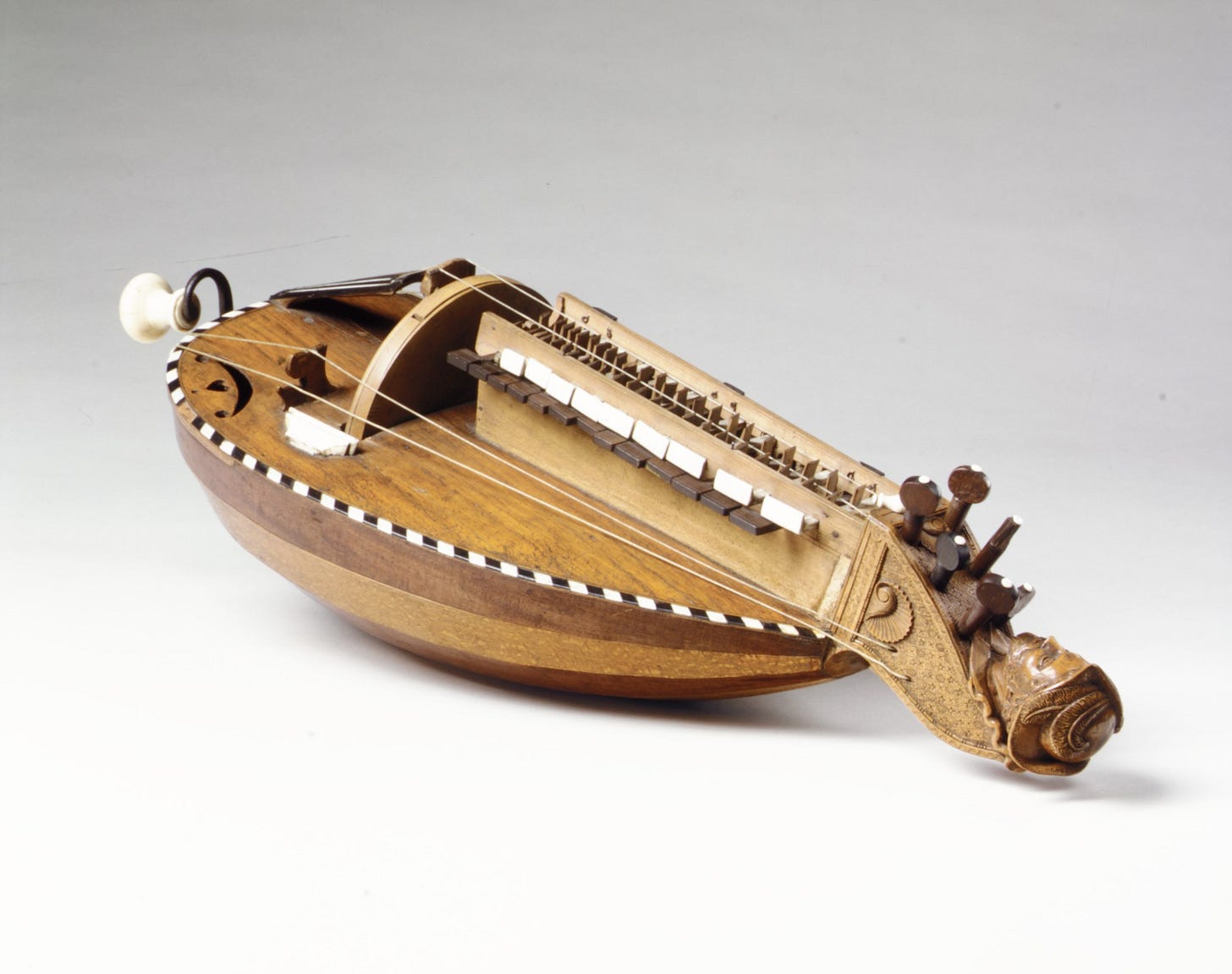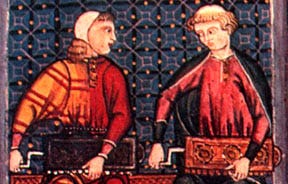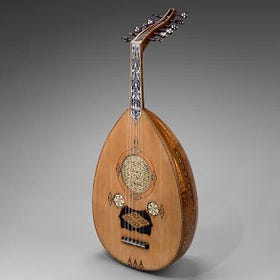
With similarities to the bagpipes, violin, and piano, the hurdy-gurdy is a unique instrument historically found across Europe, from Spain to Scandinavia and Italy to England.
History
The hurdy-gurdy traces its ancestry to the organistrum, a 10th century instrument requiring two people to operate. By the 13th century, a one-person secular version called the symphonia appeared, what is today called the hurdy-gurdy. The hurdy-gurdy was quickly adopted by street and traveling musicians who were commonly beggars, children, or poor farmers looking for a way to make an income during the winter months. Even though it was associated with the poorer classes for centuries, in the 17th century it became fashionable for aristocrats to learn how to play it.
It has since fallen out of favor with the aristocracy.

The Hurdy-gurdy
Originally box shaped, hurdy-gurdies have evolved to have either pear- or violin-shaped bodies. The pear-shaped variety closely resembles that of the oud. To produce music, the player cranks a rosined wooden wheel. As the wheel spins it acts as a violin bow and vibrates the strings. Just above the wheel is the key box, housing the tangents. A tangent is a piece of wood connected to the key at a 90 degree angle. So when a player presses a key, the tangent presses the string, shortening it to produce a note. There is one tangent per string on each key. Hurdy-gurdies have a chromatic keyboard that can range up to two octaves.
Strings
Depending on the hurdy-gurdies, there are three to four types of strings, and like the oud, they are traditionally made of gut. All hurdy-gurdies have melody, drone, and trompette strings, while some have additional sympathetic drones.
When the wheel is cranked the edge of the wooden wheel vibrates the melody strings, also known as chantrelles. The melody strings are the only set of strings affected by the keys. Next, the low drone strings function as, well, drones. They are vibrated by the wheel, but produce a single fixed pitch. Next, the trompettes, or high drones. The trompettes have a unique setup where the bridge isn’t fully attached to the instrument, giving off a buzzing sound when the player gives the wheel some extra acceleration. Players frequently use this buzzing to create interesting rhythms. Finally, some hurdy-gurdies have sympathetic strings, which are not vibrated by the wheel, but simply resonate from the vibrations of the other strings on the instrument.
The Sound
Below is Andrey Vinogradov playing “Uzh Kak Po Mostu, Mostochiku,” a Russian traditional tune.
In the video above you can see the melody strings in the middle of the instrument. The set of strings that are resting on top of the wheel (those closer to Andrey’s face) are the trompettes and the set of strings on the bottom of the wheel (those closer to Andrey’s feet) are the low drones. The two sets of strings above and below the drones are the sympathetic drones. At 0:35 seconds you can hear him start to use the trompettes to create the buzzing rhythm.
Here is an incredible performance by Matthias Loibner.
And yes, now I want a hurdy-gurdy.
If you enjoyed this look into the hurdy-gurdy, I’d love to hear your thoughts in the comments below.
Sources:
The Editors of Encyclopedia Britannica. Hurdy-gurdy. Encyclopedia Britannica, January 2024, https://www.britannica.com/art/hurdy-gurdy.
Gonzales, Sergio. The Baroque Hurdy Gurdy in XVIII Century. Interlude, April 2023, https://interlude.hk/the-baroque-hurdy-gurdy-in-xviii-century/.
Hurdy-Gurdy. Iowa State University of Science and Technology, https://www.music.iastate.edu/antiqua/instrument/hurdy-gurdy.
Hurdy-Gurdy. The Metropolitan Museum of Art, https://www.metmuseum.org/art/collection/search/501646.
Hurdy Gurdy History. Altarwind, https://www.altarwind.com/hghistory.html.
“HURDY GURDY | How It’s Made.” YouTube, uploaded by Discovery UK, youtube.com/watch?v=wfjWEqAP4WM.
Hurdy-gurdy (Medieval). Case Western Reserve University, https://caslabs.case.edu/medren/medieval-instruments/hurdy-gurdy-medieval/.
Hurdy Gurdy Tunings. Altarwind, https://www.altarwind.com/hgtuning.html.
“What is a HURDY-GURDY? How does it work? - Briefly and SIMPLY EXPLAINED!” YouTube, uploaded by Annie Hurdy Gurdy, youtube.com/watch?v=o7JyDM-rOvE.
Thank you for reading and supporting this newsletter. The best way to show support is by liking and sharing. If you would like to read more here is a link to the second edition of Instrumental Archaeology.
Instrumental Archaeology, Issue 2
Meaning “from wood” in Arabic, the oud is commonly known as the Sultan of all instruments. With its history dating back centuries, the oud is still an integral part of many styles of Arabic music today, from relig…





I want a hurdy-gurdy, too! Such a fascinating sound.
The instrument plays a pivotal role in the bleak ending of Schubert's song cycle Winterreise (Winter Journey). Over the course of 24 songs we follow a heartbroken young poet who undergoes a harrowing journey across frozen landscapes after being exiled from home. In the final song he comes upon a penniless hurdy-gurdy player, and in the final line of the piece, the poet despondently asks him: "Strange man, shall I travel with you? Will you grind your organ to my songs?"
Schubert (of course) does such a great job evoking the sound of the hurdy-gurdy:
https://www.youtube.com/watch?v=sIIS-UgixGE
Really informative, thank you. It's an amazing instrument, and once heard never forgotten. I once saw a TV drama adapted from an MR James ghost story in 1973 - "Lost Hearts" . I've never forgotten the scene where one of the ghosts plays the hurdy-gurdy. There's a clip available on YouTube but it's a bit scary!